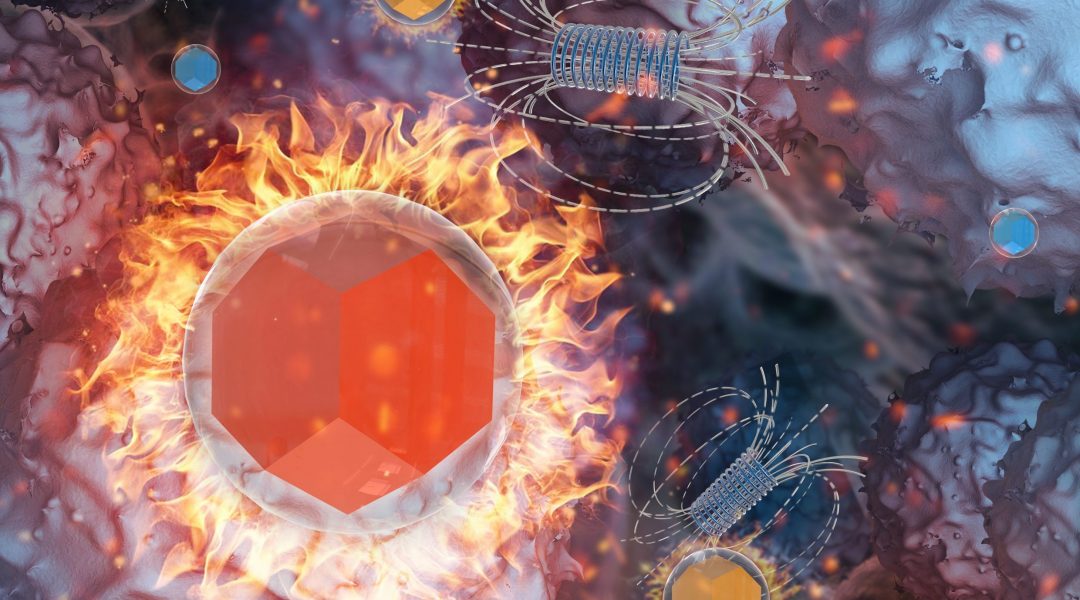
This research is highlighted as the front cover of Small Issue 29, 2018.
Maximized specific loss power and intrinsic loss power approaching theoretical limits for alternating‐current (AC) magnetic‐field heating of nanoparticles are reported by a team led by Hao Zeng from the Department of Physics at University of Buffalo.
Magnetic nanoparticle hyperthermia is a modality of cancer therapy employing heat dissipation by magnetic nanoparticles in an alternating magnetic field to kill tumor cells. Human clinical trials on treatment of brain tumors has been done in the past. The ideal application of nanoparticle hyperthermia is targeted therapy of small tumors and metastatic cancer cells, where surgical removal might be impossible. Due to the strong heat dissipation in the body, for example, from the blood flow, the smaller the tumor, the higher heating power of nanoparticles is needed to reach the temperature desired to kill cancer cells. The heating power of present magnetic particles, however, is far from adequate for such applications.
Most of the work carried out so far focuses on achieving the highest possible specific loss power, at high magnetic fields of the instrument. As the loss power depends on the magnetic anisotropy (the magnetic anisotropy is a property of a material that defines the difficulty in magnetizing the material in different directions), previous work has been done to control the anisotropy of nanoparticles by growing a shell on a core of particles with different magnetic anisotropy, or by growing particles with different shapes to control their anisotropy. However, little has been done regarding controlling the anisotropy using alloying of magnetic materials with different magnetic anisotropy. More importantly, little has been done to maximize the loss power of nanoparticles at low fields suitable for clinical applications. The reported high specific loss power in previous studies at high fields is therefore not relevant to practical applications in magnetic nanoparticle hyperthermia.
By alloying of a magnetically soft material with a magnetically hard material, the magnetic anisotropy can be tuned at will. Just the right amount of alloying will give the magnetic properties needed to maximize the heating power. This enables application in clinical hyperthermia for targeted therapy of small tumors and metastatic cancer cells, where surgical removal might be impossible. As heating can be highly localized on tumor tissues, this can be used to replace radiation or chemo therapy, with both minimal invasiveness and side effects.
In their article in Small, through careful design of magnetic properties in nanoparticles of alloyed magnetically hard and soft ferrites, the research team achieved a heating rate at low field amplitude and frequency, which is several times to an order of magnitude higher than some of the best-performing particles previously synthesized, which makes them suitable for clinical applications.
Zeng states, “The mechanism of ac field heating of nanoparticles is not different from that of an induction oven, except that the size of each individual particle used to fry cancer cells is ten million times smaller than a typical frying pan. As such, it would allow heat to be released locally on cancerous cells and spare healthy tissues.”
The research team was able to match the anisotropy with the field amplitude used in the experiment to maximize the heating power. Not only that, but these nanoparticles possess low toxicity: their toxicity is even lower than that of magnetite nanoparticles, an FDA approved materials for use as an MRI contrast agent.
Mimicking bone tumor treatment after surgical removal, efficient heating of a piece of pig bone using bone cement embedded with nanoparticles was achieved with a dosage more than an order of magnitude lower than that used in previous studies.

















